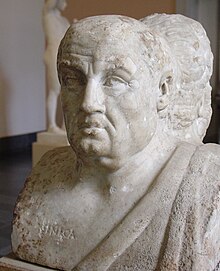 Seneca the Younger (c. 4 BC – AD 65), fully Lucius Annaeus Seneca and also known simply as Seneca (/ˈsɛnɪkə/), was a Roman Stoic philosopher, statesman, dramatist, and—in one work—humorist of the Silver Age of Latin literature. As a tragedian, he is best-known for his Medea and Thyestes.
Seneca the Younger (c. 4 BC – AD 65), fully Lucius Annaeus Seneca and also known simply as Seneca (/ˈsɛnɪkə/), was a Roman Stoic philosopher, statesman, dramatist, and—in one work—humorist of the Silver Age of Latin literature. As a tragedian, he is best-known for his Medea and Thyestes.
He was a tutor and later advisor to emperor Nero. He was forced to take his own life for alleged complicity in the Pisonian conspiracy to assassinate Nero. However, some sources state that he may have been innocent.[1][2] His father was Seneca the Elder, his elder brother was Lucius Junius Gallio Annaeanus, and his nephew was the poet Lucan.
-----------------------------------------------------------------------------------------------------------------------------
Phaedra, is a fabula crepidata (Roman tragedy with Greek subject) of c. 1280 lines of verse by philosopher and dramatist Lucius Annaeus Seneca, which tells the story of Phaedra, wife of King Theseus of Athens, and her consuming lust for her stepson, Hippolytus. Based on Greek Mythology and the tragedy Hippolytus by Greek playwright Euripides, Seneca's Phaedra is one of several artistic explorations of this tragic story. Seneca portrays the title character as knowing and direct in the pursuit of her stepson, while in other iterations of the myth she is more of a passive victim of fate. This Phaedra takes on the scheming nature and the cynicism often assigned to the Nurse character.
Seneca wrote Phaedra during the Roman Empire before 54 C.E., and the play has influenced drama over the centuries since then, particularly the works of Shakespeare and dramas of 16th and 17th century France. Other notable dramatic versions of the Phaedra story that were influenced by Seneca's version include Phèdre by Jean Racine and Phaedra's Love by Sarah Kane. Seneca's play continues to be performed today.
Major themes of Phaedra include the laws of nature as interpreted according to Stoic philosophy; animal imagery and hunting; and the damaging effects of the sexual transgressions of mothers and stepmothers.
No comments:
Post a Comment